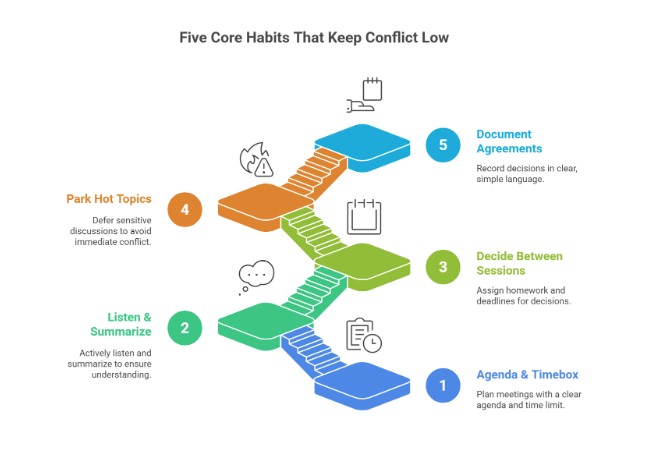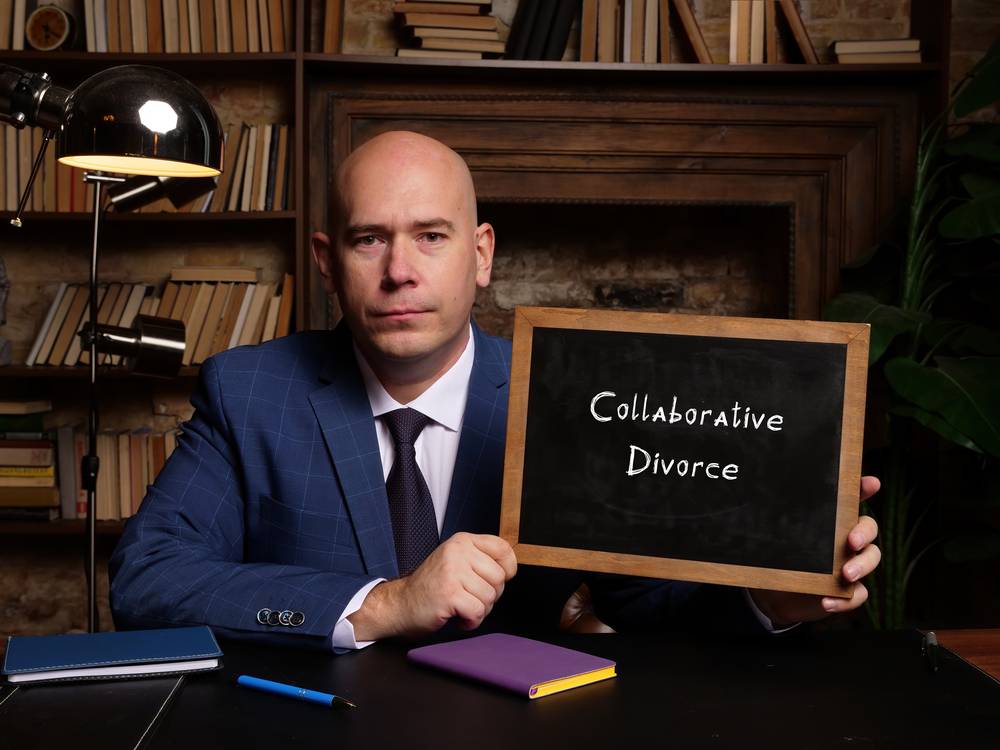I. Why Women Should Consider Collaborative Divorce: Alleviating Financial Fears
Divorce can be an emotionally charged and financially challenging experience, particularly for women who often face unique financial concerns during this time. One solution which has been gaining traction in recent years is collaborative divorce. This process emphasizes cooperation, negotiation, and transparency to create an equitable outcome for all parties involved.
Collaborative divorce involves both members of the couple working together with their respective lawyers and possibly a neutral financial professional to reach an agreement on the division of assets, debts, and other financial aspects of the divorce process. This method encourages open communication and prioritizes creating a fair settlement over adversarial litigation. By opting for a collaborative divorce, women can better address the financial fears and challenges that they often face during the divorce process.
Key Takeaways
- Collaborative divorce promotes cooperation and negotiation for a fair settlement.
- This process emphasizes financial transparency, allowing both parties to make informed decisions.
- Collaborative divorce can particularly benefit women in securing financial stability post-divorce.
II. Understanding Collaborative Divorce
A. Explanation of What Collaborative Divorce Is
Collaborative divorce is an alternative dispute resolution process focusing on a mutually respectful and cooperative approach to resolving divorce issues. In this process, both spouses and their respective attorneys work together to resolve their differences without resorting to litigation. The team may include a neutral financial specialist and a divorce coach to provide additional support and guidance.
B. Brief History of Its Emergence
Collaborative divorce emerged in the 1990s as a response to the traditional adversarial nature of divorce litigation. The process was developed by Minnesota family lawyer Stu Webb, who believed that a more cooperative and less contentious approach to divorce could better serve the needs of all parties involved.
C. Comparison with Traditional Litigation
In traditional divorce litigation, both parties are represented by attorneys who advocate for their clients in court. This process often leads to an adversarial atmosphere, as both parties fight to win the case and secure their best possible outcome. On the other hand, collaborative divorce focuses on problem-solving and open communication to reach a mutually beneficial agreement. The following table compares some key aspects of collaborative divorce and traditional litigation:
| Aspect | Collaborative Divorce | Traditional Litigation |
| Cost | Often less expensive | Can be costly |
| Time | Flexible timeline | Court-imposed deadlines |
| Privacy | Confidential negotiations | Public court proceedings |
| Control | Parties control outcome | Judge determines outcome |
| Relationships | Encourages cooperation | Can strain relationships |
Collaborative divorce can help alleviate financial fears for women by fostering a more cooperative approach, allowing for the negotiation of fair financial settlements. By avoiding traditional litigation’s costly and adversarial nature, a collaborative divorce process often ends with a more satisfactory and equitable resolution for both parties.
Footnotes
- Collaborative Divorce – SurviveDivorce.com
- Why Consider a Collaborative Divorce? – Psychology Today
- What is Collaborative Divorce? – Lawyers.com
- The Pros and Cons of the Collaborative Divorce Process – DivorceMag.com
III. The Shift from Adversarial Litigation to Collaborative Divorce
In recent years, there has been a significant shift from adversarial litigation toward collaborative divorce. This change is especially beneficial for women with financial concerns during divorce. Collaborative divorce is an alternative dispute resolution method that focuses on negotiation and problem-solving, aiming to reach a settlement that suits both parties without going to court.
One of the main reasons for this shift is the recognition that adversarial litigation often exacerbates the financial and emotional strain on the divorcing couple and their families. Collaborative divorce offers a more cost-effective and emotionally supportive approach. Parties work with their respective attorneys and other professionals like financial advisors and mental health professionals to find mutually acceptable solutions for asset division, spousal support, child custody, and other issues.
In collaborative divorce, negotiation takes center stage. Each party is represented by a collaborative attorney, who helps their client identify and communicate their needs and interests. The collaborative attorneys and parties attend a series of meetings to address each issue and develop a solid plan for moving forward. This process minimizes conflict and supports a less adversarial environment, ultimately leading to a more amicable settlement.
In addition to negotiation, collaborative divorce often incorporates a mediation approach– a voluntary process in which a neutral third-party mediator facilitates communication and the resolution of disputes. Mediation can address financial concerns by offering a less expensive path toward resolving monetary disputes and developing financial plans. Collaborative attorneys and collaborative professionals are trained as mediators and they bring those mediation skills to the collaborative divorce process.
Collaborative divorce helps alleviate financial fears in several ways. In contrast to litigation, this process is generally quicker and less costly, reducing legal fees. Furthermore, collaborative teams can assist in budgeting and financial planning, helping women address immediate and long-term financial needs.
Ultimately, the shift from adversarial litigation to collaborative divorce represents a significant change in how legal professionals approach the divorce process. By focusing on communication, negotiation, and an interdisciplinary approach, collaborative divorce offers a more practical and financially sensitive option that can be particularly beneficial for women experiencing financial concerns.
IV. Financial Transparency in Collaborative Divorce
A. Encouraging Financial Transparency
An important aspect of collaborative divorce is the emphasis on financial transparency. Both parties are encouraged to share information about their assets and debts openly, facilitating a clearer understanding of the financial situation and can help alleviate financial fears. This approach allows each spouse to comprehensively view the marital estate and work together to reach a fair and equitable division.
By fostering an atmosphere of honesty, full disclosure, and cooperation, collaborative divorce can minimize the risks of hidden assets or attempts to conceal financial information, ultimately leading to a more equitable distribution of assets and debts and increased financial security for both parties.
B. Role of Financial Professionals
In a collaborative divorce, a neutral financial specialist often becomes an essential part of the process. Their role is to analyze the couple’s assets and debts, help both parties understand their financial situation, and offer guidance in making informed decisions about property division, child support, and spousal support.
The financial neutral works as a mediator and ensures that both spouses’ financial interests are addressed fairly and transparently. With their expertise, they can identify potential tax implications, evaluate the value of assets, and provide long-term financial planning guidance. By engaging a neutral financial specialist, couples can ensure that their financial concerns are addressed, making the divorce process less stressful and more predictable.
C. Case Example
Consider a couple with many assets, including real estate, retirement accounts, and various investments. During their collaborative divorce process, they enlist the help of a neutral financial specialist to ensure financial transparency and equitable distribution.
The financial specialist first assists in disclosing all relevant financial information, helping both parties understand their rights and obligations concerning their assets and debts. Then, they work with the couple to explore various property division options, considering factors such as tax implications, the liquidity of certain assets, and each party’s individual financial needs and goals.
By incorporating financial transparency and utilizing the expertise of a neutral financial specialist in their collaborative divorce, the couple can work together to establish a secure financial future for themselves and any children involved, reducing the overall stress and uncertainty commonly associated with divorce proceedings.
V. Empowerment and Informed Decisions
A. Empowering Women through Collaborative Divorce
Collaborative divorce allows both parties to work together to resolve disputes and make informed decisions about their future. This process can empower women, encouraging a more active role in decision-making. Instead of being overwhelmed by fear and uncertainty, women can gain confidence and control by participating in a collaborative divorce process. This approach also facilitates a supportive environment where women can openly discuss their concerns, income, and financial goals with a team of qualified professionals, such as neutral financial specialists and divorce coaches1.
B. Types of Financial Decisions
Various financial decisions must be made during a collaborative divorce, such as dividing assets and liabilities, child support, and spousal support arrangements. Here are some critical financial aspects to consider:
- Income: Evaluating and disclosing each spouse’s income is an essential data point to determine equitable child and spousal support.
- Retirement accounts: The division of retirement accounts, such as 401(k)s, IRAs, or pensions, can significantly impact each spouse’s long-term financial stability.
- Decision-making: Collaborative divorce allows both parties to participate actively in financial decision-making, promoting fairness and transparency.
C. Long-Term Impact on Women’s Financial Stability
The collaborative divorce process can positively impact women’s financial stability by allowing them to address their financial fears and make informed decisions about their future. By working with a neutral financial specialist and a divorce coach, women can better understand their financial situation and receive guidance on how to achieve a stable future. This process also allows for the equitable division of assets, including retirement accounts, to help ensure a secure financial future for both parties,
Footnotes
- What is Collaborative Divorce, and is it right for you?
- The Pros and Cons of the Collaborative Divorce Process
VI. Benefits of Collaborative Divorce for Women’s Financial Stability
A. Control over the Process
One of the main benefits of collaborative divorce for women’s financial stability is the level of control they have over the process. Collaborative divorce involves direct input from both parties and their respective legal representatives, which allows for more equitable negotiations and decision-making. This collaborative approach ensures that financial concerns, such as the allocation of assets and liabilities, are addressed fairly and transparently.
Good communication between the parties is essential in collaborative divorce, as it helps to promote an atmosphere of trust and cooperation. This can provide significant relief for women apprehensive about their financial future following a high-conflict divorce.
B. Reduced Stress and Fair Outcomes
Collaborative divorce generally reduces stress for women, as the process aims for fair outcomes rather than pitting both parties against each other. In traditional divorce proceedings, stress can be exacerbated by aggressive litigation tactics, negatively impacting both parties’ financial matters. In contrast, the collaborative approach allows for a more level playing field, helping to create more equitable and fair financial solutions.
A key factor in this process is the involvement of financial professionals, who can assist women in understanding their financial situation and the potential outcomes of the divorce. Through the guidance of these experts and the open communication encouraged by the collaborative process, women can feel more confident and knowledgeable about their financial futures, alleviating the financial fears often associated with divorce.
VII. Case Study
A. Real-Life Example
In a recent collaborative divorce case, Jane and John, a couple in their mid-40s with two children, decided to end their marriage. They agreed to prioritize their children’s well-being and secure a fair financial settlement for both parties. To achieve this, they opted for the collaborative divorce process.
Through open communication and transparency, Jane and John worked alongside attorneys, a mental health professional, and a financial neutral. Their financial neutrality provided unbiased advice and helped the couple understand the financial implications of their decisions.
B. Analysis of the Case Study
The inclusion of a financial neutral in this collaborative divorce allowed Jane and John to:
- Identify their financial interests, including saving for their children’s college education and purchasing new homes.
- Gain a clear understanding of their assets and liabilities for a reasonable property division.
- Understand tax implications of their settlement agreement.
- Create a workable budget for each post-divorce, considering their incomes, expenses, and future financial goals.
- Develop a child support and alimony plan that addressed both of their concerns and ensured the well-being of their children.
This case study showcases the benefits of collaborative divorce, particularly for women who may have financial fears during the divorce process. By involving financial neutrality and maintaining open communication, this method aids in achieving an equitable division of assets, addressing future financial plans, and mitigating the family’s negative impact.
VIII. Conclusion
In collaborative divorce, both spouses work with a legal team and other professionals to agree on terms such as financial settlements and child custody arrangements. This approach has shown to be particularly beneficial for women seeking to maintain financial stability during and after the divorce. Instead of engaging in a costly and adversarial legal battle, collaborative divorce fosters a cooperative environment that focuses on developing solutions tailored to the needs of all family members.
The involvement of financial professionals in the collaborative divorce process is crucial to ensure fair and sustainable financial outcomes. They can help both parties understand their current financial situation, explore different options, and design a financial plan for the future. By doing so, women can feel more confident in their financial decisions and better prepare to establish a stable economic foundation following the divorce.
In summary, women looking to alleviate financial fears during a divorce should consider a collaborative divorce. This approach fosters cooperation and respect between both parties and ensures a more comprehensive understanding of their finances. By actively shaping their financial future, women can navigate the process with a sense of empowerment, clarity, and security.
























